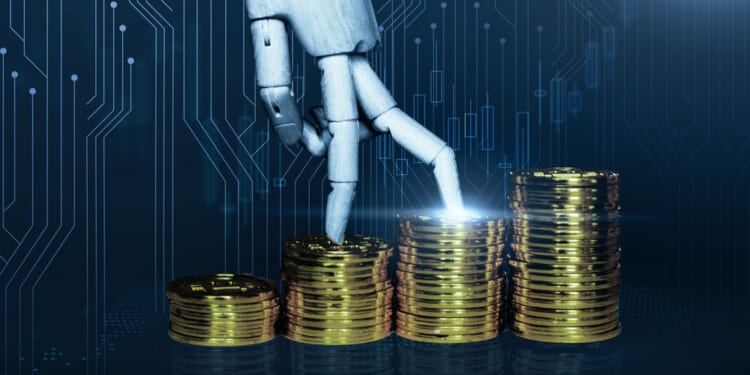Warnings of an AI market bubble are growing louder. If valuations collapse, crypto could face amplified losses—though decentralized AI may emerge stronger in the aftermath.
Fund managers, experts, and institutions are increasingly warning of an artificial intelligence (AI) bubble. The Bank of England cautioned that the risk of a sharp market correction has increased, noting that equity valuations have been stretched for tech firms in the AI space. Goldman Sachs CEO David Solomon predicted a market drawdown in the next 12-24 months, and drew explicit parallels to the dotcom bubble. World Economic Forum President Børge Brende identified crypto, AI, and debt as three potential bubbles forming simultaneously. More recently, a Bank of America survey found 54 percent of fund managers believe AI stocks are in a bubble.
These warnings, coming from prominent financial institutions, go beyond theoretical grounds. They’re founded on a record degree of market concentration: extreme valuations in the AI sector. Nvidia recently made history by becoming the first firm to reach above a $5 trillion market valuation. Today, the chipmaker dominates 8.5 percent of the entire S&P 500, which is above the bottom 240 firms combined. The top five tech firms control 30 percent of the index, the highest concentration in 50 years. With AI-related firms responsible for 75 percent of all US stock market gains, the broader market’s performance is increasingly dependent on AI bets paying off. OpenAI lost $13.5 billion on $4.3 billion in revenue in the first half of 2025, yet is targeting a $1 trillion IPO. These are the types of numbers that have preceded painful corrections in the past.
Crypto’s Correlation and Vulnerability
From a crypto market perspective, this presents a true paradox. Crypto is vulnerable as an adjacent emerging technology sector that shares the same speculative capital and risk-on sentiment driving AI investments. Bitcoin’s correlation with the NASDAQ has been markedly strengthened, especially during times of AI uncertainty, which means that if tech investors hit the panic button, it’s probable that they will pull back across the board. Recall 2022, when rate increases and tech selloffs hit crypto even harder than stocks. If AI valuations collapse, it’s reasonable to expect crypto to suffer amplified losses as investors flee from anything speculative.
The mechanics are well established. During risk-off environments, crypto doesn’t decline along tech stocks. It tends to decline faster and farther. During 2022, with the Federal Reserve’s increase in interest rates and tech stocks in a bear market, Bitcoin fell 65 percent from its high while the Nasdaq declined 33 percent. Each time tech stocks sold, this pattern was repeated: crypto amplified this decline.
Structural Drivers Behind Amplified Losses
The reasons for this amplification have structural roots. The size and liquidity levels in crypto markets are much lower than those in equity markets. Institutional traders with huge exposure cannot exit big positions in Apple and Microsoft without substantially affecting market levels. They can exit crypto positions easily, which is why it is sold first in a deleveraging situation. These same entities have exposure to both areas. In addition to AI, venture capital firms also have significant crypto portfolio exposure. When their AI bets sour, and partners demand returns, those firms will liquidate. With its 24/7 trading and quick exit options, crypto is the best option.
Mining ventures have turned to AI infrastructure, exchanges have rolled out AI trading instruments, and crypto projects have rebranded with AI terms. Once AI sentiments turn sour, these ventures will be even riskier extensions of this same bubble. AI tokens will be wiped out, and this problem will affect the rest of the crypto markets due to correlation and sentiment.
The Macroeconomic Multiplier
There is also a macroeconomic component to keep in mind. An AI bubble popping would not occur by itself. It would happen alongside economic troubles: a recession, a liquidity crisis, or a high interest rate. In that environment, crypto has historically performed poorly. It’s a negative-yielding, speculative asset with no cash flows. When investors are genuinely scared and seeking safety, they buy treasury bonds and gold, not Bitcoin.
But there’s another narrative that’s much harder to dismiss. The market cap for crypto AI agent tokens has escalated to over $15 billion, and a decentralized AI market is growing as a counterbalance to centralized AI infrastructure, where OpenAI and Anthropic control 88 percent of AI-native company revenue. If the AI bubble bursts, decentralized alternatives built on crypto rails could actually gain credibility and capital.
After the Pop
The question for crypto investors is whether the sector will be collateral damage in an AI correction or whether it could be positively impacted by it. The answer is: a little bit of both, but not in equal measure. The immediate impact of an AI correction will certainly hurt crypto. Capital will flee risk assets, correlations will rise, and crypto’s higher volatility means it will fall harder and faster than traditional tech stocks.
However, the longer-term picture could be different. If the AI bubble pops because centralized AI proves to be too capital-intensive with unclear unit economics, the narrative around decentralized alternatives would become more compelling. The question isn’t whether crypto will avoid short-term loss, because it won’t. The question is how well crypto’s AI infrastructure positions itself as a legitimate alternative in the aftermath.
About the Author: Emily Vartuhi
Emily Vartuhi is a Young Voices contributor based in Washington, DC. She is a graduate of the Columbia University Graduate School of Journalism MS program. Emily writes on the emerging technologies sector, such as digital asset policy, blockchain, AI, and tech use-cases for public good.
Image: Have a nice day Photo/shutterstock

















